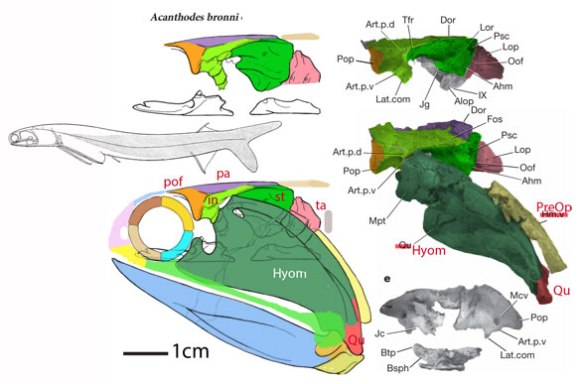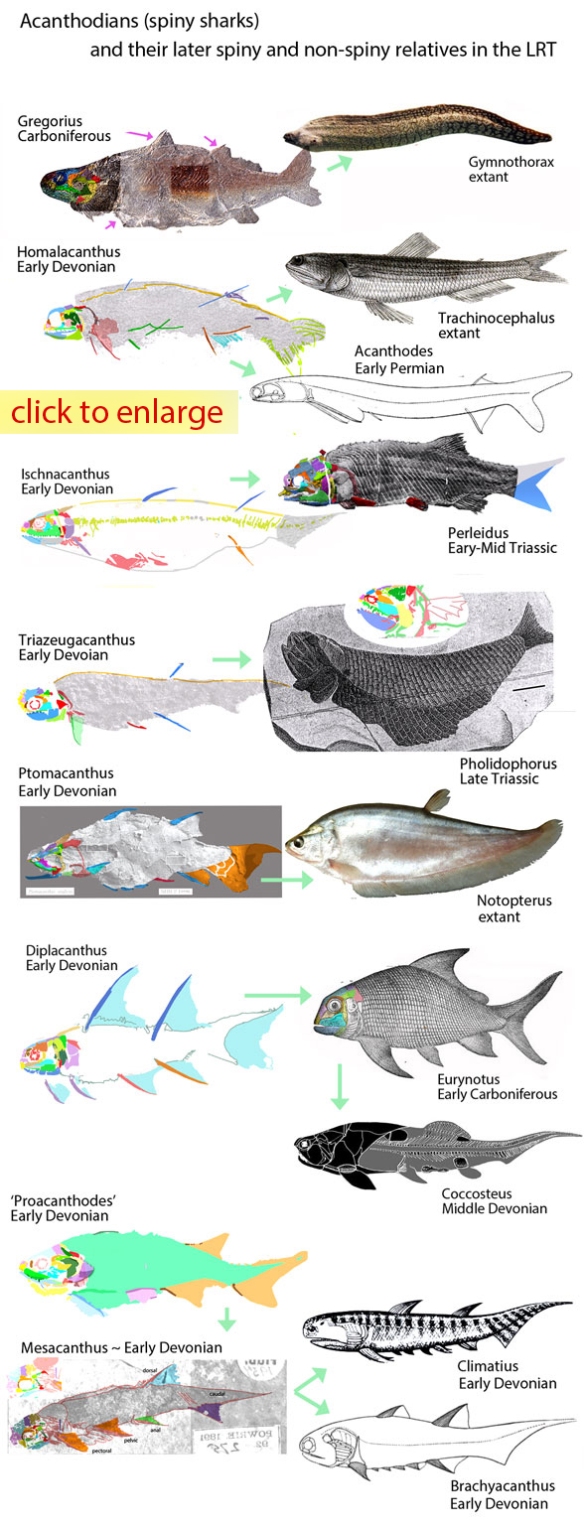The namesake for the clade of spiny sharks,
Acanthodes (Figs. 1, 2), is often touted as the last and best preserved member of the Acanthodii. The braincase and hyomandibular arch are well preserved in 3D, but the cheek and rostral bones are entirely absent. Here (Fig. 1) those elements are restored based on phylogenetic bracketing.

Figure 1. Acanthodes skull with elements restored. The fragility of those elements is why we don’t have them.
Acanthodes bronni (Anonymous 1880; Early Permian 290 mya; 20cm) is the latest occurring acanthodian, the largest and has the best ossified braincase. Davis et al. mislabeled the hyomandibular as a giant quadrate and the preopercular as the mislabeled hyomandibular. Acanthodes is toothless and presumed to be a filter feeder. No extra spines are present. Other species can reach 41cm.

Figure 2. Acanthodes in situ.
Reports that acanthodians are the last common ancestors
of sharks and bony fish (Friedman and Brazeau 2010, Davis, Finarelli and Coates 2012) are not supported by the LRT. However, acanthodians are basal to a wide variety of stem lobefin bony fish and placoderms in the LRT.

Figure 2. Click to enlarge. Acanthodians and their spiny and non-spiny relatives in the LRT (subset Fig. 2), not to scale.
According to Davis et al. 2012:
“Acanthodes bronni remains the only example preserved in substantial detail, central to which is an ostensibly osteichthyan braincase.”
That’s because it nests with bony fish in the LRT (subset Fig. x).

Figure x. Newly revised fish subset of the LRT
Davis et al. continue:
“These data contribute to a new reconstruction that, unexpectedly, resembles early chondrichthyan crania. Principal coordinates analysis of a character–taxon matrix including these new data confirms this impression.”
Every time principal component analysis is used instead of phylogenetic analysis, things go awry. For example, Bennett 19xx is infamous for giving gender identities to large and small Pteranodon specimens, not realizing that phylogenetic analysis nests small taxa with Germanodactylus outgroups and large taxa as highly derived.
Davis et al continue:
“However, phylogenetic analysis places Acanthodes on the osteichthyan stem, as part of a well-resolved tree that also recovers acanthodians as stem chondrichthyans and stem gnathostomes.”
Unfortunately, Davis et al. do not employ a longer list of taxa to understand the tree topology the LRT recovers. Here acanthodians are recovered as stem tetrapods. The basal split between Amia and spiny sharks is missing from the Davis et al. 2012 cladogram.
References
Anonymous 1880. Royal Physical Society of Edinburgh (1880). “Proceedings of the Royal Physical Society of Edinburgh”. V: 115.
Davis SP, Finarelli JA and Coates MI 2012. Acanthodes and shark-like conditions in the last common ancestor of modern gnathostomes. Nature 486:247–250.
Friedman M and Brazeau 2010. A reappraisal of the origin and basal radiation of the Osteichthyes. Journal of Vertebrate Paleontology 30(1):36–56.
wiki/Acanthodii
wiki/Acanthodes
